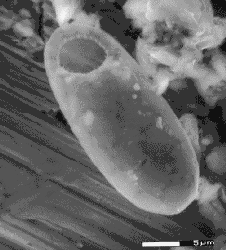Introduction to the Testaceafilosea
the testate amoebae
 There are a number of protists
that are amoeboid; that is, they are
more or less shapeless and move by means of extensions known as
pseudopodia ("false feet"). This has been achieved many times in various
eukaryote lineages; amoebas are a highly polyphyletic group.
A number of amoebas are referred to as testate:
they are partially enclosed in a shell, or test, that may be made of organic
material, agglutinated particles, calcium carbonate, or silica. The testate
amoebae probably make up a polyphyletic group,
but one group of testate amoebae, the Testaceafilosea, is probably
monophyletic, united by the synapomorphies of having long, thread-like
pseudopodia and a test that is often made of silica plates.
There are a number of protists
that are amoeboid; that is, they are
more or less shapeless and move by means of extensions known as
pseudopodia ("false feet"). This has been achieved many times in various
eukaryote lineages; amoebas are a highly polyphyletic group.
A number of amoebas are referred to as testate:
they are partially enclosed in a shell, or test, that may be made of organic
material, agglutinated particles, calcium carbonate, or silica. The testate
amoebae probably make up a polyphyletic group,
but one group of testate amoebae, the Testaceafilosea, is probably
monophyletic, united by the synapomorphies of having long, thread-like
pseudopodia and a test that is often made of silica plates.
The test of Trinema is shown here; Trinema is very common
in the water films on mosses, in leaf litter, in moist soils, and on
aquatic vegetation. (This specimen in particular was found on
moss just
outside of McCone Hall on the UC-Berkeley campus.) In life, the amoeboid
cell would partialy fill the hollow test and extend pseudopodia from the
aperture seen at the upper left.
Although these testate amoebae are non-photosynthetic and lack flagellated
stages, their coating of siliceous scales is similar to that seen in some
chromists.
For this reason, some have placed the Testaceafilosea near the Chromista. A
recent molecular study (Bhattacharya et al. 1995) rejects this position but
suggests that these amoebae may actually be closely related to another algal
group, the Chlorarachniophyta.
Certainly more work will be required to pinpoint the relationships of these
organisms.
The oldest filose testacean fossils may be late Precambrian,
but because tests rapidly
disintegrate into individual scales after the death of the amoeba, fossil
Testaceafilosea are not well-known. However, tests of these and other amoebae
may be common in Cenozoic and Quaternary lake deposits and peats, where they may
provide information on paleoclimate and paleoecology.
 UCMP Research Report: "Bacteria
and protozoa from middle Cretaceous amber of Ellsworth County, Kansas."
Find out more about fossil testate amoebas from Cretaceous amber, a
unique mode of preservation. Originally published in
PaleoBios
17(1): 20-26.
UCMP Research Report: "Bacteria
and protozoa from middle Cretaceous amber of Ellsworth County, Kansas."
Find out more about fossil testate amoebas from Cretaceous amber, a
unique mode of preservation. Originally published in
PaleoBios
17(1): 20-26.

Source:
Bhattacharya, D., Helmchen, T., and Melkonian, M. 1995. Molecular evolutionary
analyses of nuclear-encoded small subunit ribosomal RNA identify an
independent rhizopod lineage containing the Euglyphina and the
Chlorarachniophyta. Journal of Eukaryotic Microbiology 42(1): 65-75.


 There are a number of protists
that are amoeboid; that is, they are
more or less shapeless and move by means of extensions known as
pseudopodia ("false feet"). This has been achieved many times in various
eukaryote lineages; amoebas are a highly polyphyletic group.
A number of amoebas are referred to as testate:
they are partially enclosed in a shell, or test, that may be made of organic
material, agglutinated particles, calcium carbonate, or silica. The testate
amoebae probably make up a polyphyletic group,
but one group of testate amoebae, the Testaceafilosea, is probably
monophyletic, united by the synapomorphies of having long, thread-like
pseudopodia and a test that is often made of silica plates.
There are a number of protists
that are amoeboid; that is, they are
more or less shapeless and move by means of extensions known as
pseudopodia ("false feet"). This has been achieved many times in various
eukaryote lineages; amoebas are a highly polyphyletic group.
A number of amoebas are referred to as testate:
they are partially enclosed in a shell, or test, that may be made of organic
material, agglutinated particles, calcium carbonate, or silica. The testate
amoebae probably make up a polyphyletic group,
but one group of testate amoebae, the Testaceafilosea, is probably
monophyletic, united by the synapomorphies of having long, thread-like
pseudopodia and a test that is often made of silica plates.
 UCMP Research Report:
UCMP Research Report:

